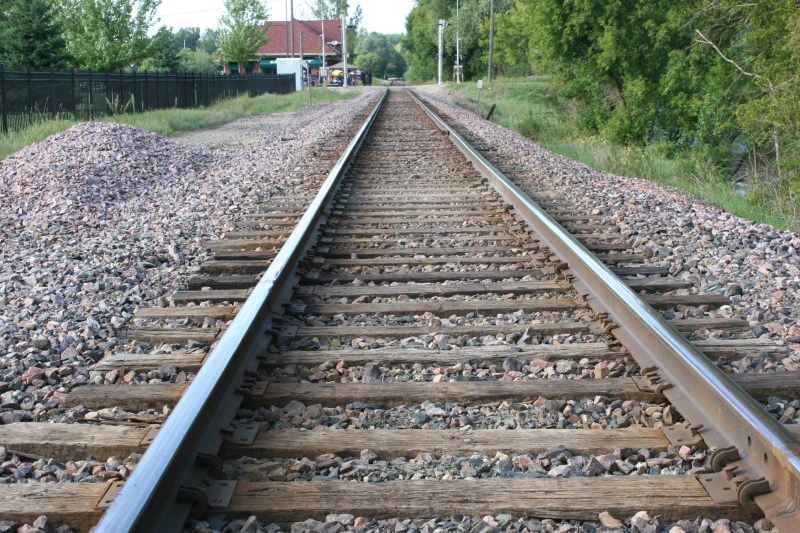
These tracks run past The Depot Bar & Grill (in the background) in my community of Faribault, Minnesota. I can hear these trains from my home. Minnesota Prairie Roots file photo.
SOMETIMES IN THE EVENING, when the traffic lessens on my busy street, I hear the train, horn blasting, wheels rumbling from the tracks just blocks away.

Railroad art created by John Cartwright. The Shoreview artist was selling copies of his ink drawings during the 2012 Railroad Swap Meet in Randolph, Minnesota. Visit his website at ArtRail.com for more information. Minnesota Prairie Roots file photo 2012.
There was a time, decades ago, when railroads connected communities, carrying passengers and freight, grain, coal… Bringing mail and goods like lumber and much more. But those days are long gone, those versatile trains all but a memory for many rural Minnesota communities.
Sure, trains still run, but along main routes and without the diverse economic importance of decades past.
With the railroad’s demise in the late 1960s and early 1970s, also came the abandonment of train depots. Many of those hubs of commerce were torn down or left to decay. But some remain. In Faribault, a former depot houses The Depot Bar & Grill, among my favorite local dining spots. Another historic depot serves as a business center.
And in the nearby small town of Kenyon, the once busy Chicago Great Western Railroad depot serves as a gathering spot at Depot Park. You can rent the building—with amenities of refrigerator, stove, sink, restroom, 29 chairs and eight tables—for $30 weekdays or for $40 on a Saturday or Sunday.
On a recent day trip to Aspelund Peony Gardens & Winery, Randy and I stopped first at Kenyon’s Depot Park for a picnic lunch. It’s a lovely spot, centered by that depot, a playground and a swimming pool.
After finishing my turkey sandwich, grapes and strawberries, I grabbed my camera and walked over for a closer look at the old depot, built around 1885. I peered inside the windows, studied the roof-line, read the signage. The railroad once held an important place in Kenyon and the surrounding area by providing freight and passenger service. Immigrants arrived here by train. Farmers shipped milk, awaited the arrival of seed and tools and farm implements. And mail.
When rail service shut down here in the late 1960s or early 70s (I read conflicting information online), a local house mover bought the depot. And in 1974, he, upon approval of the city, moved the depot to the park.
But there’s one more interesting piece of history about this building, a story shared in a 2012 letter to The Kenyon Leader written by former Mayor John L. Cole. According to Cole, the Kenyon High School Class of 1975 was tasked with painting the depot after “getting into trouble” during a class trip to Grandview Lodge in Brainerd. Now he doesn’t explain what that “trouble” may have been. But Cole thanks the class, emphasizing that something good came out of the bad.
As a 1974 high school graduate (from a school nowhere near Kenyon), I can only guess. We were on the tail end of the Vietnam War, a bit vocal and determined and rebellious. My class got into trouble for choosing “Dead Skunk in the Middle of the Road” as our class song. Not exactly fitting for a high school graduation ceremony. I expect had we gone on a trip like the teens from Kenyon, we, too, would have gotten into trouble.
I digress. But history has a way of connecting us. Through stories. Through places. Like depots that hold the history of a community and its people.
© Copyright 2020 Audrey Kletscher Helbling















Recent Comments